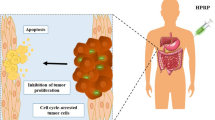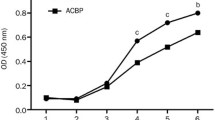Abstract
Purpose
As the conventional therapeutic approaches were not completely successful in the treatment of colon cancer, there is still a need for finding the most efficient therapeutic agents. Here we investigated the anticancer activity of HPRP-A1 that was derived from the N-terminal region of Helicobacter pylori ribosomal protein L1 (RpL1) alone or in combination with tumor-homing peptide iRGD and 5-Fluorouracil (5FU) on colon cancer cell lines (CT26 and HT29) and isograft models of colon cancer.
Method
We assessed the tumor growth inhibitory activity of HPRP-A1 with or without iRGD and 5FU on colon cancer in vitro and in vivo. In the in vitro part, we investigate the effect of HPRP-A1 alone and in combination with iRGD/5FU.
Results
Our results demonstrated that co-administration of HPRP-A1 with iRGD increased the apoptosis, while these two peptides in combination with 5FU increased the intracellular level of p53 that upregulate the pro-apoptotic gene BAX and downregulate the anti-apoptotic gene BCL2. HPRP-A1 blocks the cell cycle progression in G0/G1. Co-administration of two peptides significantly reduced the size and weight of the tumors, while the group that received 5FU in combination with the peptides increased the necrotic and decrease the fibrotic area significantly in the tumor tissues, which also disrupt the oxidant/antioxidant balance.
Conclusions
Our results indicated that HPRP-A1 could be considered an effective agent toward colon cancer in vitro and in vivo with the ability to enhance the effects of conventional chemotherapy agent 5FU.








Similar content being viewed by others
References
Abedizadeh R, Rezvan H, Nourian A (2020) A new in vivo model for analysis of colon carcinoma micrometastasis in BALB/c mice. J Shahrekord Univ Med Sci 22(2):88–95
Aebi H (1984) Catalase in vitro. Methods Enzymol 105:121–126
Amerizadeh F, Rezaei N, Rahmani F, Hassanian SM, Moradi-Marjaneh R, Fiuji H et al (2018) Crocin synergistically enhances the antiproliferative activity of 5-flurouracil through Wnt/PI3K pathway in a mouse model of colitis-associated colorectal cancer. J Cell Biochem 119(12):10250
Boohaker RJ, Lee M, Vishnubhotla P, Perez JLM, Khaled AR (2012) The use of therapeutic peptides to target and to kill cancer cells. Curr Med Chem 19(22):3794–3804
Cao C, Yan TD, Black D, Morris DL (2009) A systematic review and meta-analysis of cytoreductive surgery with perioperative intraperitoneal chemotherapy for peritoneal carcinomatosis of colorectal origin. Ann Surg Oncol 16(8):2152–2165
Chang J, Liu Y, Han B, Zhou C, Bai C, Li J (2015) Pseudomonas aeruginosa preparation plus chemotherapy for advanced non-small-cell lung cancer: a randomized, multicenter, double-blind phase III study. Med Oncol 32(5):139
Cohen E, Ophir I, Shaul YB (1999) Induced differentiation in HT29, a human colon adenocarcinoma cell line. J Cell Sci 112(16):2657–2666
Dinarvand P, Hassanian SM, Weiler H, Rezaie AR (2015) Intraperitoneal administration of activated protein C prevents postsurgical adhesion band formation. Blood 125(8):1339–1348
Elmi S, Sallam NA, Rahman MM, Teng X, Hunter AL, Moien-Afshari F et al (2008) Sulfaphenazole treatment restores endothelium-dependent vasodilation in diabetic mice. Vascul Pharmacol 48(1):1–8
Fujimori M (2006) Genetically engineered bifidobacterium as a drug delivery system for systemic therapy of metastatic breast cancer patients. Breast Cancer 13(1):27–31
Giovannetti E, Wang Q, Avan A, Funel N, Lagerweij T, Lee JH et al (2014) Role of CYB5A in pancreatic cancer prognosis and autophagy modulation. J Natl Cancer Inst 106(1):djt346
Gontero P, Bohle A, Malmstrom P-U, O’Donnell MA, Oderda M, Sylvester R et al (2010) The role of bacillus Calmette-Guérin in the treatment of non–muscle-invasive bladder cancer. Eur Urol 57(3):410–429
Gupta PK, Tripathi D, Kulkarni S, Rajan M (2016) Mycobacterium tuberculosis H37Rv infected THP-1 cells induce epithelial mesenchymal transition (EMT) in lung adenocarcinoma epithelial cell line (A549). Cell Immunol 300:33–40
Haabeth OAW, Lorvik KB, Hammarström C, Donaldson IM, Haraldsen G, Bogen B et al (2011) Inflammation driven by tumour-specific Th1 cells protects against B-cell cancer. Nat Commun 2(1):1–12
Haabeth OAW, Lorvik KB, Yagita H, Bogen B, Corthay A (2016) Interleukin-1 is required for cancer eradication mediated by tumor-specific Th1 cells. Oncoimmunology 5(1):e1039763
Hamilton AM, Aidoudi-Ahmed S, Sharma S, Kotamraju VR, Foster PJ, Sugahara KN et al (2015) Nanoparticles coated with the tumor-penetrating peptide iRGD reduce experimental breast cancer metastasis in the brain. J Mol Med 93(9):991–1001
Han E-S, Muller FL, Pérez VI, Qi W, Liang H, ** L et al (2008) The in vivo gene expression signature of oxidative stress. Physiol Genomics 34(1):112–126
Hao X, Yan Q, Zhao J, Wang W, Huang Y, Chen Y (2015) TAT modification of alpha-helical anticancer peptides to improve specificity and efficacy. PLoS ONE 10(9):e0138911
Hao W, Hu C, Huang Y, Chen Y (2019) Coadministration of kla peptide with HPRP-A1 to enhance anticancer activity. PLoS ONE 14(11):e0223738
Hetz C, Bono MR, Barros LF, Lagos R (2002) Microcin E492, a channel-forming bacteriocin from Klebsiella pneumoniae, induces apoptosis in some human cell lines. Proc Natl Acad Sci 99(5):2696–2701
Hu C, Chen X, Huang Y, Chen Y (2018a) Co-administration of iRGD with peptide HPRP-A1 to improve anticancer activity and membrane penetrability. Sci Rep 8(1):2274
Hu C, Huang Y, Chen Y (2018b) Targeted modification of the cationic anticancer peptide HPRP-A1 with iRGD to improve specificity, penetration, and tumor-tissue accumulation. Mol Pharm 16(2):561–572
Hu C, Chen X, Huang Y, Chen Y (2018c) Synergistic effect of the pro-apoptosis peptide kla-TAT and the cationic anticancer peptide HPRP-A1. Apoptosis 23(2):132–142
Hu C, Chen X, Huang Y, Chen Y (2018d) Co-administration of iRGD with peptide HPRP-A1 to improve anticancer activity and membrane penetrability. Sci Rep 8(1):1–14
Kang H-L, Lee W-K, Song J-Y, Choi S-H, Park S-G, Ryu B-D et al (2005) Helicobacter pylori Strain 51 (Korean Isolate): ordered overlap** BAC Library, combined physical and genetic map, and comparative analysis with H. pylori strain 26695 and strain J99. J Microbiol Biotechnol 15(4):844–854
Kuwana T, Bouchier-Hayes L, Chipuk JE, Bonzon C, Sullivan BA, Green DR et al (2005) BH3 domains of BH3-only proteins differentially regulate Bax-mediated mitochondrial membrane permeabilization both directly and indirectly. Mol Cell 17(4):525–535
Lax AJ (2005) Bacterial toxins and cancer—a case to answer? Nat Rev Microbiol 3(4):343
Lecuit M, Abachin E, Martin A, Poyart C, Pochart P, Suarez F et al (2004) Immunoproliferative small intestinal disease associated with Campylobacter jejuni. N Engl J Med 350(3):239–248
Lemoine L, Sugarbaker P, Van der Speeten K (2016) Pathophysiology of colorectal peritoneal carcinomatosis: role of the peritoneum. World J Gastroenterol 22(34):7692
Marjaneh RM, Rahmani F, Hassanian SM, Rezaei N, Hashemzehi M, Bahrami A et al (2018) Phytosomal curcumin inhibits tumor growth in colitis-associated colorectal cancer. J Cell Physiol 233(10):6785–6798
Marqus S, Pirogova E, Piva TJ (2017) Evaluation of the use of therapeutic peptides for cancer treatment. J Biomed Sci 24(1):21
Nath G, Gulati AK, Shukla VK (2010) Role of bacteria in carcinogenesis, with special reference to carcinoma of the gallbladder. World J Gastroenterol: WJG 16(43):5395
Nautiyal J, Kanwar SS, Yu Y, Majumdar AP (2011) Combination of dasatinib and curcumin eliminates chemo-resistant colon cancer cells. J Mol Signal 6(1):1–11
Pütsep K, Brändén C-I, Boman HG, Normark S (1999) Antibacterial peptide from H. pylori. Nature 398(6729):671
Qifan W, Fen N, Ying X, **nwei F, Jun D, Ge Z (2016) iRGD-targeted delivery of a pro-apoptotic peptide activated by cathepsin B inhibits tumor growth and metastasis in mice. Tumor Biol 37(8):10643–10652
Roberts NJ, Zhang L, Janku F, Collins A, Bai R-Y, Staedtke V et al (2014) Intratumoral injection of clostridium novyi-NT spores induces antitumor responses. Sci Transl Med 6(249):249ra111-249ra111
Ruoslahti E (2017) Tumor penetrating peptides for improved drug delivery. Adv Drug Deliv Rev 110:3–12
Shin K, Lee J, Guo N, Kim J, Lim A, Qu L et al (2011) Hedgehog/Wnt feedback supports regenerative proliferation of epithelial stem cells in bladder. Nature 472(7341):110–114
Shin K, Lim A, Zhao C, Sahoo D, Pan Y, Spiekerkoetter E et al (2014) Hedgehog signaling restrains bladder cancer progression by eliciting stromal production of urothelial differentiation factors. Cancer Cell 26(4):521–533
Siegel RL, Miller KD, Jemal A (2020) Cancer statistics, 2020. CA: Cancer J Clin 70(1):7–30
Sugahara KN, Teesalu T, Karmali PP, Kotamraju VR, Agemy L, Girard OM et al (2009) Tissue-penetrating delivery of compounds and nanoparticles into tumors. Cancer Cell 16(6):510–520
Sugahara KNTT, Karmali PP, Kotamraju VR, Agemy L, Greenwald DR, Ruoslahti E (2010) Coadministration of a tumor-penetrating peptide enhances the efficacy of cancer drugs. Science 328(5981):1031–1035
Sugarbaker PH (2016) Improving oncologic outcomes for colorectal cancer at high risk for local–regional recurrence with novel surgical techniques. Expert Rev Gastroenterol Hepatol 10(2):205–213
Teesalu TSK, Kotamraju VR, Ruoslahti E (2009) C-end rule peptides mediate neuropilin-1-dependent cell, vascular, and tissue penetration. PNAS 106(38):16157–16162
Teesalu T, Sugahara KN, Ruoslahti E (2013) Tumor-penetrating peptides. Front Oncol 3:216
Wang J-L, Liu D, Zhang Z-J, Shan S, Han X, Srinivasula SM et al (2000) Structure-based discovery of an organic compound that binds Bcl-2 protein and induces apoptosis of tumor cells. Proc Natl Acad Sci 97(13):7124–7129
Wei MQ, Ellem KA, Dunn P, West MJ, Bai CX, Vogelstein B (2007) Facultative or obligate anaerobic bacteria have the potential for multimodality therapy of solid tumours. Eur J Cancer 43(3):490–496
Yan L, Kanada M, Zhang J, Okazaki S, Terakawa S (2015) Photodynamic treatment of tumor with bacteria expressing killerred. PLoS ONE 10(7):e0131518
Zhang Y, Davis C, Ryan J, Janney C, Peña MMO (2013) Development and characterization of a reliable mouse model of colorectal cancer metastasis to the liver. Clin Exp Metas 30(7):903–918
Zhao M, Yang M, Ma H, Li X, Tan X, Li S et al (2006) Targeted therapy with a Salmonella typhimurium leucine-arginine auxotroph cures orthotopic human breast tumors in nude mice. Can Res 66(15):7647–7652
Acknowledgements
This study was a part of a Ph.D. dissertation by Atieh Yaghoubi.
Funding
This research was funded by Mashhad University of Medical Sciences, Mashhad, Iran (981262).
Author information
Authors and Affiliations
Corresponding authors
Ethics declarations
Conflict of interest
The authors have declared that have no conflict of interest.
Additional information
Publisher's Note
Springer Nature remains neutral with regard to jurisdictional claims in published maps and institutional affiliations.
Rights and permissions
About this article
Cite this article
Yaghoubi, A., Asgharzadeh, F., Movaqar, A. et al. Anticancer activity of Helicobacter pylori ribosomal protein (HPRP) with iRGD in treatment of colon cancer. J Cancer Res Clin Oncol 147, 2851–2865 (2021). https://doi.org/10.1007/s00432-021-03683-7
Received:
Accepted:
Published:
Issue Date:
DOI: https://doi.org/10.1007/s00432-021-03683-7




